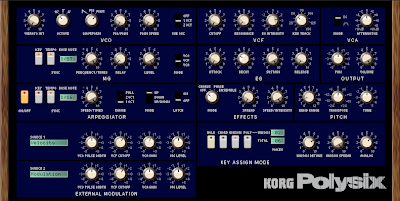
(Click image to enlarge and see settings)
Although it has its origins in the early 2000's, it wasn't until the last 2-3 years that dubstep emerged out of the deepest recesses of the underground. Although still semi-obscure, the popularity of dubstep has increased enough that there are several dubstep-oriented sample libraries on the market now. But of course, it's much more fun to make your own sounds, so today I'm going to show you how to program a dubstep bass using Korg's excellent PolySix emulation.
1. Load up an instance of Polysix in your sequencer of choice. It defaults to the Fat Line Bass setting, which is as good as any place to start. For whatever reason, square (pulse) waves seem to be the most common waveform used in making dubstep basses, so go ahead and chance the WAVEFORM to PW or PWM. It doesn't matter which, as we won't be modulating the pulse width, we'll just be leaving it as a square. While you're in the VCO section, go ahead and drop the OCTAVE setting to 16', as this is the lowest.
2. The original sound is sort of short and plucked, but we want a sustaining sound, so head over to the EG section and throw the SUSTAIN level all the way up to 10. Your ATTACK and RELEASE should be set at 0, and because of the SUSTAIN setting, the DECAY setting isn't important.
3. Next, go up to the VCF section, and turn the filter's CUTOFF all the way down to 0. It's pretty dark and muffled now, but don't worry, we'll be modulating it to change that.
4. So head over to the MG section (Modulation Generator... Korg's name for an LFO). Change the MOD switch to VCF so we're telling the MG to modulate the filter. Make sure the KEY and TEMPO buttons are both selected. Dubstep is a style that relies heavily on syncopation and triplet feels, so we're going to set the BASE NOTE to 1/8T (triplet eigth notes). Note that changing the LFO rate throughout the course of a bassline is quite popular in dubstep, and you can do that by changing the BASE NOTE setting using your sequencer's automation.
5. Finally, we want this sound to be big and fat, so make sure your KEY ASSIGN MODE is set to UNISON. Crank the UNISON DETUNE up to around 6 or 7 and the UNISON SPREAD all the way to 10.
If you've done everything correctly, you should have something that sounds like this (note that I am automating the BASE NOTE setting here as mentioned above):




















8 comments:
Following your series on Rolling your own Bass, wicked stuff so far! I (try to) make them all with NI's Massive, and that seems to work pretty ok. Keep up the great work!
Cheers, Statik.
Tom, tak a look:
http://www.etsy.com/shop.php?user_id=6852312
Yeah, I saw those on Matrixsynth or one of the other blogs. Funny.
great bassline tutorials!
Im a dubstep producer myself and disagree on alot in this tutorial. I apreciate someone writing a blog like this but please to some real study before posting in the future.
The bass in dubstep isn't " square" based. It's based on a sine, and saw waveforms. Or a combo of more.
There's a specific technique to achieve this bass. And the biggest producers out there do it this way:
sine and two saw waves detuned. Split the freq's into 3 bands. Low (30hz to 150 hz), mid (150 to 3500khz) and hi (3500 to 20000 hz).
Then apply different modulated effects to both mid and hi channels. Think of chorus, delay, ringmods, phaswers, flangers, distortion etc.
Then when you have a little "moving" bass, you resample and import it into kontakt. Then to exactly the same as above but with some more modulation. Then do the same, then do the same then do the same.. you get it right?
When your satisfied with the basssound you import it in a sampler like kontakt again and put a lowpass with lfo or a chopper on top and modulate it.
Now that's a dubstep bass alla 16bit and 501 and the likes. They also call this a Reese bass, it originates from drum n bass (neurofunk especially).
I don't want to offend you but the example you posted sounds real shitty...
Good luck anyway, i hope you can do something with my tips.
Actually the Reese bass originates from Techno. It was originally created by Kevin "Reese" Saunderson, after which it is named.
PT TWIN Logistics perusahaan Ppjk ingin menawarkan kerjasama dalam bidang pengurusan barang Import RESMI & BORONGAN.
Services Kami,
Customs Clearance Import sistem Resmi maupun Borongan
Penanganan secara Door to Door ASIA & EROPA Sea & Air Service
Penyediaan Legalitas Under-Name (Penyewaan Bendera Perusahaan)
Pengiriman Domestik antar pulau seluruh Indonesia laut dan Udara atau Darat.
Keterangan tambahan :
1. Nomor Induk Berusaha ( NIB ) : 1257002601078
2. IT ( Mainan, Elektronic, Garmen, Sepatu dan Peralatan kaki lainnya )
3. SPI-PI Besi Baja,
4. SPI-PI Produk Kehutanan,
5. SPI-PI Barang Bekas,
6. SPI-PI Tekstil & Izin TPT
7. Produk-produk Lartas SNI
8. LS ( Laporan Surveyor )
9. LS Alas kaki
10. LS Garment
11. LS Textile
12. LS Electronik
Terima kasih atas kepercayaan kepada kami, semoga kerjasamanya berjalan dengan baik dan lancar.
Jika ada pertanyaan lebih lanjut, Bpk/ Ibu dapat menghubungi Customer Support PT TWIN Logistics melalui Nomor Phone : +62 21 8498-6182, 8591-7811 Whatssapp : 0819-0806-0678 E-Mail : andijm.twinlogistics@yahoo.com
Mr. Andi JM
Hp Whatssapp : 0819-0806-0678 / 0813-8186-4189
= = = = = = = = = = = = = = = = = = = = = = = = = = = == = = = =
PT TUNGGAL WAHANA INDAH NUSANTARA
Jl. Raya Utan Kayu No.105 B Jakarta Timur 13120 Indonesia
Phone : +62 21 8498-6182, 8591-7811 Fax : +62 21 8591-7812
Email : pt.twinlogistics@yahoo.com, andijm@twin.co.id
Web : www.twinlogistics.co.id , https://www.twin.co.id
Post a Comment